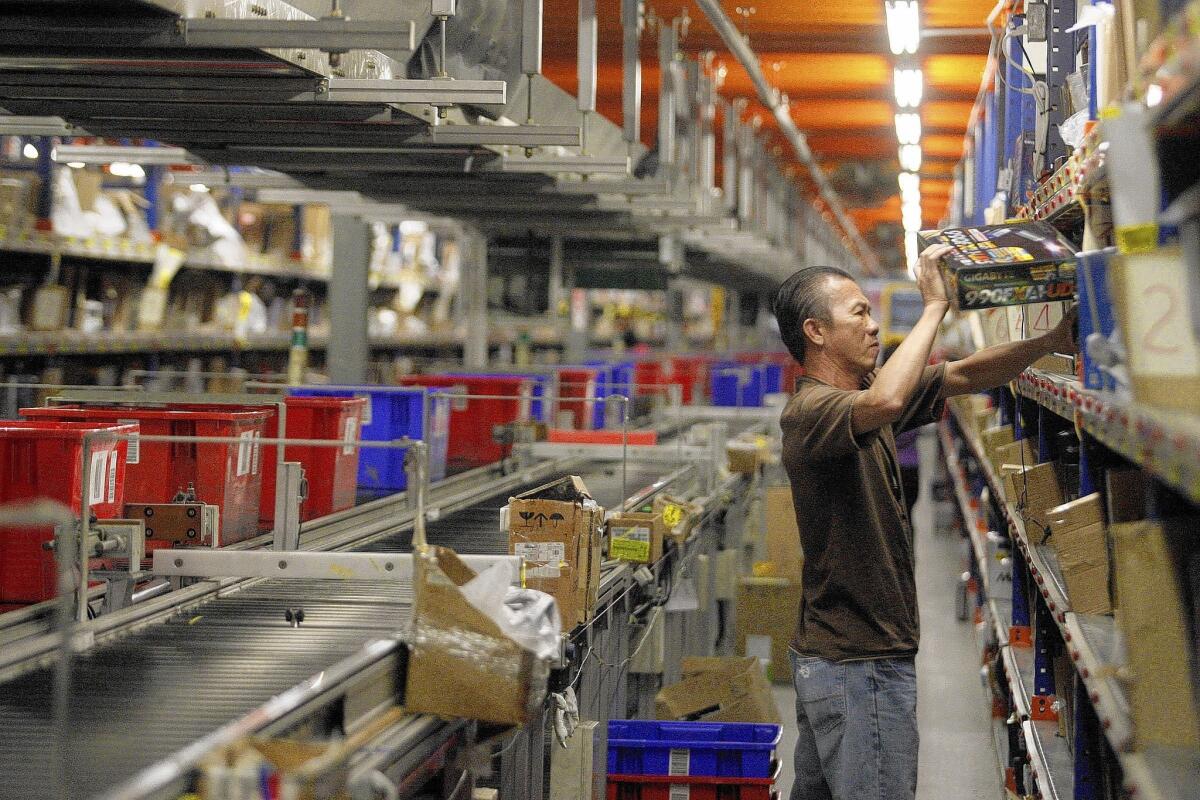Demand for e-commerce warehouses spurs development in Southland

Robust demand for buildings from e-commerce companies and conventional retailers eager to boost their online sales is reshaping the country’s industrial real estate market and spurring development in the Southland.
Developers are racing to build warehouses for retailers who have already promised to rent them. Others are just starting construction on “spec,” betting that a retailer will be ready to rent the buildings by the time they are completed, a new report by CBRE Group Inc. said.
Southern California, with its dense population and major seaports where international goods arrive, is one of the country’s biggest hubs of e-commerce.
Those businesses are running at a blistering pace. By 2017, online transactions could account for more than 10% of all U.S. retail sales, up from 6.2% in 2013, according to Adam Mullen, head of supply chain services for CBRE Group.
“To keep up with growing demand, e-commerce companies and, increasingly, traditional retailers are making major investments in big-box facilities that function both as warehouses to store goods and distribution centers to fulfill online orders,” Mullen said.
A maze of conveyor belts at the Newegg Inc. shipping center in the City of Industry, for instance, collects merchandise so rapidly that the online retailer is able to ship about 15,000 packages a day to customers in the West.
Digital cameras, tablets, hard drives and software discs are among the 40,000 unique items Newegg has ready to ship at a moment’s notice. Nearly 100 workers staff the facility known as a fulfillment center six days a week.
Amid the rapid growth, Newegg is opening another fulfillment center in Indiana next month. That will bring its number of centers in North America to eight.
“We are the second-largest pure-play online retailer after Amazon,” said Kunal K. Thakkar, senior vice president of global operations.
In Southern California, the Inland Empire is among the biggest product distribution markets in the U.S. and is experiencing a boost in development.
More than 16 million square feet of industrial facilities is under construction in the Riverside and San Bernardino counties, accounting for about 14% of all the industrial space being built in the U.S.
“That’s the most development I can remember in a decade or two,” said Kurt Strasmann, head of CBRE’s industrial brokerage operations in Southern California.
Of the 34 projects under construction, 29 are 100,000 square feet in size or larger. Many of them are specifically designed to handle e-commerce order fulfillment.
An affiliate of CT Realty announced plans last week for still more construction. The Aliso Viejo developer will build two industrial buildings totaling more than 350,000 square feet on Jurupa Road in Fontana.
Work on the $28-million speculative project will begin in November, said Carter B. Ewing, managing partner of CT Realty.
“Very few industrial class buildings below 200,000 square feet are currently available or under construction, while tenant demand for these state-of-the art facilities is exploding,” Ewing said. “Our development plan has been specifically designed to meet this market imbalance.”
For the immediate future, developers will build big warehouses where they can find the space to put them, a recent report by brokerage Lee & Associates said.
“The Inland Empire, with its abundance of land available for development and relatively cheaper land values compared to neighboring Los Angeles and Orange counties, will continue to be a construction hot spot,” the report said.
The hot market also creates opportunities for landlords of vacant bulk space who can afford to invest in upgrades to current e-commerce standards, such as abundant electrical power and enough restrooms and parking to serve bigger workforces than average warehouses require, CBRE Group’s Strasmann said.
And as giant companies such as Google, Amazon and EBay press for same-day deliveries, the need for warehouses and fulfillment centers will expand to densely populated areas like Los Angeles. Because land there is more expensive than in the Inland Empire, the buildings will probably need to rise in height rather than spread out.
Japan and Europe already have vertical e-commerce buildings in central cities, Strasmann said.
“We are in the really early stages of this still,” he said of e-commerce-related real estate expansion in the U.S. “There will be great demand and growth in that sector for a long time coming.”
Twitter: @rogervincent
More to Read
Inside the business of entertainment
The Wide Shot brings you news, analysis and insights on everything from streaming wars to production — and what it all means for the future.
You may occasionally receive promotional content from the Los Angeles Times.











